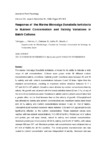Response of the Marine Microalga Dunaliella tertiolecta to Nutrient Concentration and Salinity Variations in Batch Cultures

Use este enlace para citar
http://hdl.handle.net/2183/14914Coleccións
- Investigación (FCIE) [1228]
Metadatos
Mostrar o rexistro completo do ítemTítulo
Response of the Marine Microalga Dunaliella tertiolecta to Nutrient Concentration and Salinity Variations in Batch CulturesData
1986Cita bibliográfica
Fabregas J, Herrero C, Cabezas B, Liaño R, Abalde J. Response of the marine microalga dunaliella tertiolecta to nutrient concentration and salinity variations in batch cultures. J Plant Physiol 1986;125(5):475-84. http://dx.doi.org/10.1016/s0176-1617(86)80010-4
Resumo
The marine microalga Dunaliella tertiolecta is known for its ability to tolerate a wide range of salt concentrations. Cultures were grown under 56 different nutrient concentration-salinity conditions. Optimal growth conditions were between 25 and 35 ‰ salinity and with nutrient concentrations between 8 and 32 times higher than the standard concentrations, resulting in maximum cellular densities between 8.41 x 106 and 16.74x 106 cells/ml. Growth is more affected by nutrient concentration than by salinity. No growth was obtained with the lowest salinities tested (0 and 5 ‰) at any of the nutrient concentrations used. Variations in salinity and in nutrient concentration had a greater effect on the final biomass than on the velocity of growth. Chlorophyll-a/ml was affected by salinity and nutrient concentrations and maximum values were found with 30 ‰ salinity and nutrient concentrations between 8 and 64 mM of NaNO3. Chlorophyll-a/cell reached maximum values between 2.02 and 3.51 pg/cell and is only significantly affected by the nutrient concentration. These maximum values were reached with low nutrient concentrations (1-2 mM of NaNO3). Protein per ml of culture and protein per cell were closely related to salinity and nutrient concentrations. Maximum protein per ml occurred at 20-25 ‰ salinity and 64mM of NaNO3, with values between 926 and 957 μml. Maximum protein/ cell concentrations were obtained also at 64 mM of NaNO3 for all the salinities. The nitrate-protein transformation rate was related to nutrient concentration and was independent of salinity. Maximum rate was
100% at 20 ‰ salinity and 1 mM of NaNO3. This rate decreased as nutrient concentrations increased.
Palabras chave
Chlorophyll a
Protein
Dunaliella
Microalga
Nutrients
Salinity
Protein
Dunaliella
Microalga
Nutrients
Salinity
Versión do editor
ISSN
0176-1617





